Whether your down and feather pillow is brand new or a pillow you have
loved for years, the thing they both have in common is they must be
fluffed. Did you know there is actually some tips and tricks you MUST
know to get the best support out of your down and feather pillow?
There is! Let’s start at the beginning.
Brand new down and feather pillow
When you buy your new down and feather pillow from Pillows.com, it
will arrive compressed. Most the air has been removed from inside the
pillow and the down and feathers have now fallen flat. Don’t let this
scare you. All this new pillow needs is some good fluffing.
Step 1 – Take the pillow out of the packaging. Start pushing some air
into the pillow by grabbing the fabric on each side of the pillow and
fan them in and out like a bellow. This will push strong blasts of air
inside the pillow and give those down and feathers some life. This
first fluffing may take some extra time since you need to push a lot
of air into it. After you do this step for a few minutes, you should
notice a big difference in the pillows loft. If you got a larger
pillow size like a queen or king, follow these steps and then place
your pillow in the dryer on low or no heat and run the cycle for 20
minutes.

Step 2 – PILLOW PROTECTORS are down and feather pillows’ best friend.
These perfectly tight fitting cotton cases will insure your pillow
doesn’t fall flat. You use these with a normal pillowcase. Place your
pillow inside the pillow protector and then put your pillowcase over
that. Not only will your pillow have better support but it will help
protect your down and feather pillow and help it last longer.

Getting your lofty full pillow inside a pillow protector and pillowcase can sometimes be hard. I learned a new trick to make it easier! Look!



Daily fluffing steps
Step 1 – While your pillow is inside the pillow protector and
pillowcase, do a few quick “bellow” fluffing movements. Grab the
fabric on each side of the pillow and fan them in and out to give some
strong blasts of air into the pillow. Rotate pillow and do again.
Shake the pillow up a little to get the filling to move around. We
want those down and feathers to not stick to each other.
Step 2 – Grab the top of the fabric of the opening of the pillowcase
and do a shake down motion. This will help the pillow to settle down
deep into the pillowcase and give us extra fabric to do the “hotel
pillowcase fold”

Step 3 – This hotel housekeeping trick really makes a difference! Once
you have that extra fabric pulled up, lay your pillow down and tuck in one side and fold in the other on top of that. Straighten out the edges and that’s it! Voila! A perfectly fluffed and folded down and feather pillow that will support you all night long. Once you get used
to doing this, it should take about a minute to complete and will
truly make your pillow that much better!




*** products used in photos are the Pillowtex 75/25 in Standard Size – https://www.pillows.com/pidoandfepi.html and the Pillowtex Pillow Protector – https://www.pillows.com/pillowtex-protectors.html




















